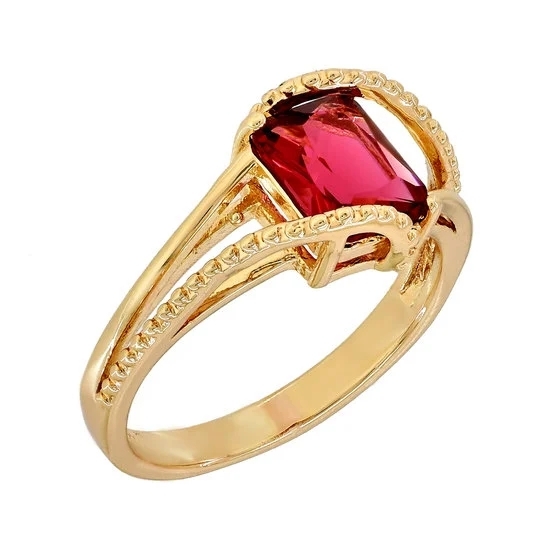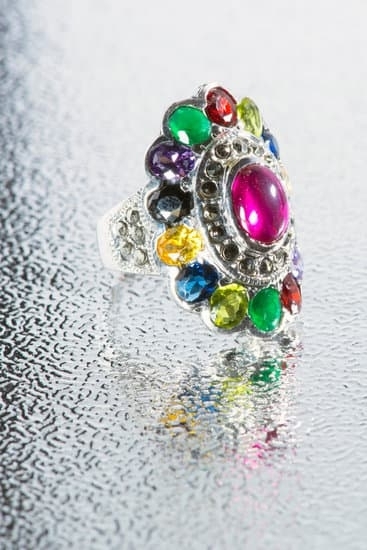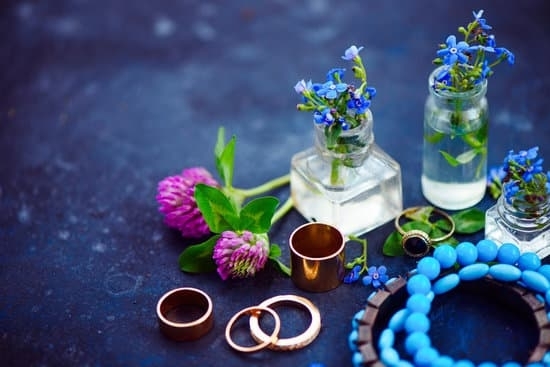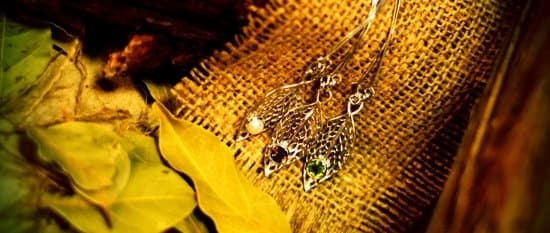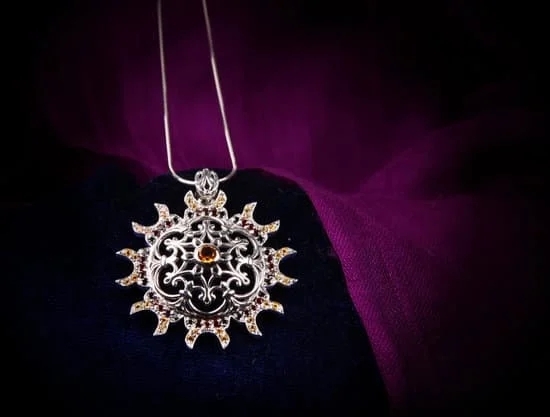One jewelry maintenance method that is useful for many types of jewelry is to be sure to inspect the piece regularly for any signs of wear and tear. Being sure to glance over your favorite piece once a week can help you complete small mends before they become large ones, as well as identifying when a special cleaning or buffing might be needed. However, not all pieces require the same attention and not all have the same best maintenance practices.
Different types of gems and materials used in making jewelry require various levels of care. Gold jewelry, while resilient and able to endure some amount of wear and tear, needs to be kept clean with mild soap and warm water – along with a soft-bristled toothbrush. They should also be allowed to air dry; do not use a cloth or paper towel as this may cause scratches on the surface.
When this particular type of jewelry is stored, it should never come into contact with other metals like silver as they may cause discoloration due to chemical reactions between them.
Silver jewelry, in comparison, can handle more frequent cleaning using a polishing cloth or even professional services where needed; however it must always be stored away from extreme temperatures and humid environments which can lead to tarnishing – both the soft kind caused by air pollution as well as hard tarnish which requires heavy duty steps to remove correctly.
Complex multi-colored gemstones usually call for specialized advice for safekeeping purposes due to their fragility. The front face generally requires extra attention such as avoiding impact or rough surfaces as much as possible – setting them away from areas where there’s active movements like kitchens are also highly recommended.
If water damage appears on the stone itself then an experienced technician should be consulted immediately so that they do not suffer irreparable harm while cleaning up whatever happened. With these precautions implemented you will ensure that these finely crafted items remain priceless no matter how old they are.
How to Choose a Professional Jewelry Cleaner
When a person wears jewelry, it can become dull, scratched or start to accumulate dirt with regular use. Everyone has their own preferences when it comes to maintaining the sparkling look of their favorite pieces of jewelry. While some prefer to use simple home remedies such as baking soda and vinegar to clean jewelry, others swear by professional cleaners for optimum results.
When selecting a professional cleaner, there are a few steps you need to take in order to make sure that your jewelry is safe in their hands. Firstly, check the reputation of any prospective professional jeweler by seeing if they have any positive customer reviews or recommendations from friends and family. Doing so will will give you an idea of the type of job they offer and any past experiences customers have had with them in the past.
Secondly, ask what methods the jeweler uses to clean jewelry and overall care for your items before you entrust them with its maintenance. This way you can be certain that your jewels are being safely handled with demonstrated processes and techniques suitable for each piece of jewelry you present them with.
Last but not least make sure that the jeweler provides insurance for any possible damages during cleaning processes just to make sure that whatever happens with your item it is covered financially.
Beyond choosing a reputable professional cleaner, many people today make use of ultrasonic waves which dissolve dirt particles on jewels via sound vibrations. Professional cleaners who specialize in this process have undergone rigorous training and must demonstrate knowledge about particular types of stones and alloys used in modern jewellery crafting before being certified by Ultrasonic Wave Cleaners (UWC).
All sonic cleaners should also provide replacement or repair services on pieces damaged due to negligent behaviour while accepting full resonsibility for consequential damages caused by incorrect handling prior cleaning processbeginning.
To conclude, taking proper care of one’s jewellery is important especially when depending on professionaljewellers who must be held accountable when dealing with intricate pieces requiring specialised attentionand maintenance procedures in order to shine once again free from scratches or dirtiness accumulated overtime.
Safely entrusting professionals means selecting those whose reputations precede them through customer reviews while understanding jewellery maintenance methods they employ is fundamental when deciding which service best fits individual needs Expectationsshouldbe realistic and repairs ought come with added securityof insuranceshould damage occur alongthe proscess.Only then can we ensure our prized possession remainsthe glitteringpridealwaysto beholdtimeafter time.
DIY Jewelry Cleaning Solutions
When it comes to looking after and maintaining your jewelry, it’s important to do it the right way. Jewelry can become damaged or discolored if not properly taken care of, so it is essential to know how to clean jewelry in the most effective way. One of the most common ways is to use DIY jewelry cleaning solutions.
Creating a DIY jewelry cleaning solution can be done with just a few household ingredients that are easy to access and mix together. A typical concoction includes warm water and dishwashing liquid, preferably ones without harsh chemicals as they can damage delicate metals, or even just a bit of lemon juice or white vinegar.
The mixture should be placed in a bowl or cup that fits the size of piece being cleaned and left for around 5 minutes while gently moving the solution around off the pieces surface using your hands.
It’s always important to ensure all mixers are at room temperature before you begin and ensure you rinse each item carefully before removing from the bowl and take extra time drying them off with a dry rag or lint-free cloth once removed from the solution. That way you can make sure all areas are covered before putting away for later use.
Always check labels too as some fabrics may require special treatments when cleaning such as pearls which require only lukewarm water, mild soap and soft rubbing with a toothbrush
DIY Jewelry cleaning solutions are great for regular maintenance although more stubborn stains may require professional assistance from a highly skilled jeweller however this process is still recommended for restoring shine on pieces easily. Just remember patience is key here, so take your time when handling your jewels each day and over time keep them shinning like new.
Tips for Selecting the Right Cleaning Solution
When it comes to jewelry maintenance, most people are aware that they need to be cleaned periodically. Not only does it keep them looking beautiful, but the cleaning also ensures that their materials and structure remain intact for many years. The first step in maintaining your jewelry is selecting the right cleaning solution for the job. Depending on the material of your jewelry, different cleaners may be required.
When you purchase your cleaner, make sure to check if it is designed specifically for the type of materials your jewelry is made from. For example, precious metals such as gold and silver have a much softer surface than stainless steel and other alloys.
Precious metals require a special cleaner, while alloys can usually be cleaned with a milder solution. You’ll also want to consider the gemstones on your piece, as some gems require special treatment with cleaning solutions to avoid any damage or discoloration.
Once you’ve purchased an appropriate cleaner for your item, go over each piece carefully before beginning. Identify any dirt or grime that needs to be removed or areas where tarnish has accumulated. If there appears to be excessive dirt or buildup of some sort, use a soft brush like a toothbrush to work out these areas without damaging the metal’s integrity before using any chemical solution.
This should help ensure that your cleaning process doesn’t cause any harm to either your stones or memberships. Now apply the cleaning solution onto a cotton swab and gently rub across the entire surface in circular motions until all dirt and grime is removed from the piece (for more stubborn spots spot clean them directly). Finally rise off any remaining cleaner with clean water using a soft cloth until dry and no longer visible streaks remain on its surface.
Regular maintenance should help keep your pieces sparkling and will help maintain their beauty over time* Repeat this process at least once every few weeks or month depending on how often you wear or use each individual item. Once you’ve finished make sure not just store back away correctly by storing them correctly away in airtight boxes/pouches which will further helps preserve them longer term by reducing their exposure dust / moisture etc .
Cleaning Silver Jewelry
Silver jewelry requires very little maintenance due to its natural properties, however, it is important to keep the item clean in order to preserver its quality and shine. The most effective and safest way to clean silver jewelry is with a commercial jewelry cleaning solution specifically designed for silver. However, if a cleaning solution is not available, certain everyday household items can be used.
To begin the cleaning process, start by using a soft bristled toothbrush and warm water mixed with some mild dish soap. Gently scrub the piece all over to loosen any built-up dirt or debris before rinsing it off with water and drying with a soft cloth.
For those pieces that may need more attentiveness, there are some other effective homemade solutions such as baking soda mixed with water or white vinegar mixed with lemon juice. Before applying either of these mixes to the jewelry, perform a skin test on an inconspicuous area in case you may have an allergic reaction. Use a soft toothbrush to apply either mix on the piece for a deep clean before rinsing off and drying with a lint-free cloth.
Another common mishap when cleaning silver jewelry is discoloration caused by tarnish – this can occur on higher quality sterling silver pieces or those mixed with other metals such as copper or brass. A good option for removing tarnish is good old-fashioned bleach but please keep in mind that this should only be used on items that don’t gemstones as they may erode away so always consult with a professional jeweler regarding their expertise.
Mix up equal parts dishwashing liquid and chlorine bleach in water then soak your piece(s) for around 15 minutes before rinsing off thoroughly of course. Again make sure you dry your pieces completely after each step mentioned here to avoid any potential oxidation damage.
With regular maintenance using any of these methods plus proper storage away from direct sunlight you can enjoy your beautiful silver jewellery for years to come.
Cleaning Gold Jewelry
Gold jewelry is a timeless and beautiful accessory to complete any look. However, as with all jewelry it needs to be cared for properly in order to maintain its shine and luster. Cleaning gold jewelry is not necessarily a difficult task, but it does require some simple steps to get the job done.
The first step in cleaning gold jewelry is to gather some supplies that you will need: warm water, detergent-free soap, a soft brush (such as a soft toothbrush), and a lint-free cloth. Begin by washing your hands with warm water and soap before handling the jewelry. You should then mix some detergent-free soap with warm water in a bowl or container and dip the gold pieces into the mixture.
Let them soak for at least 3 minutes before softly brushing off any dirt or debris using the soft brush. Make sure to be gentle when brushing so that you don’t scratch or damage the gold.
Once the jewelry has been cleaned, you can rinse off all of the mixture using warm running water and pat dry using a lint-free cloth. You can also use this same method for cleaning diamond-encrusted jewelry or silver pieces; however, avoid using abrasive materials such as steel wool on gold pieces as they can easily scratch and damage them.
Lastly, make sure that your pieces are always stored away from direct sunlight or extreme temperatures because both of these can cause discoloration over time.
By following these steps regularly, you can keep your gold jewelry looking Radiant for many years to come. Additionally, it may be wise to bring your fine jewelry pieces in every 6 months or so to your local jeweler so they can inspect them for any signs of wear and tear or loose stones that need tightening before any major problems occur due to neglect.
Taking care of your precious accessories properly will go along way towards making sure that they maintain their brilliance for many generations.
Cleaning Gemstones & Crystals
Gemstones and crystals can be deceivingly tricky to clean and maintain. The first step to ensure that your sparkling stone is given the care it needs is to make sure you’re using the correct cleaning method for it. Gemstones and crystals come in many varieties, each with different maintenance instructions.
For example, some stones should never be soaked in water as this could damage them or cause a colour change. Others might need a mild detergent with warm water to get rid of dirt build-up without damaging the stone.
One of the best ways to keep your gemstones and crystals looking point is by caring for them on a regular basis. Cleaning your gems after every use will keep them sparkly and snatch away any left-over dirt or residues that have gathered since their last cleaning session.
In order to do this correctly, start off by dampening a soft cloth with some warm water, then add just enough mild detergent so that it barely foams up when rubbed between the fingertips.
Next gently rub your stone with the cloth to remove any built-up particles or dirt whilst being mindful not to rub too hard as this could scratch up delicate pieces such as Turquoise or Lapis Lazuli. Finally rinse, dry & enjoy.
By following these guidelines for your gemstone’s individual needs you’ll also become familiar with how it feels and looks when in pristine condition revealing any signs of wear before further damage occurs from general wear & tearusage. Additionally, if worn often nail polish remover can be used on metal settings of jewelry which helps loosen oils from everyday handling back into the jewellery so that they don’t transfer onto clothes or skin.
This method works great for gemstone beads and cabs but should never be used on gems set in rings and other pieces with intricate settings as heat generated by solvents can eventually weaken very tightly held components over time.
Care Tips for Caring for Fine Jewelry
Caring for fine jewelry can be tricky as precious metals and gemstones are delicate materials. Maintaining sparkle, luster and condition is essential to preserve its value. Here are some important tips on how to properly care and maintain your fine jewelry pieces:
1. Store Your Jewelry Properly: To keep your jewelry looking great, store each piece separately in a fabric-lined jewelry box or pouch to avoid abrasion with other pieces. Always ensure the box is kept away from direct sunlight or extreme temperatures.
2. Cleaning Tips: Cleaning should be done regularly using warm water and mild soap or detergent-free dishwashing liquid, then gently drying with a soft cloth. When cleaning deep set gems like diamonds, use an extra-soft brush to avoid any damage caused by scraping from other harder brushes. Ultrasonic cleaners are usually not recommended unless instructed by the manufacturer since it could cause surface wear & tear of gold & platinum pieces due to their ultra sonic vibrations.
3. Care Tips for Use: Take your jewelry off when undertaking household tasks such as cooking or cleaning which could involve the use of harsh chemicals, detergents and unduly raising temperatures which may cause metal discolouration and general wear & tear of the metal as well as stones used in the piece of jewelry you’re wearing.
Avoid exposing your jewels in salt water too often as this will speed up oxidation process on some metals like silver over time which eventually causes undesirable tarnishing that cannot always be reversed without professional help so it’s best avoided.
4. Regular Checkups: Have regular checkups done on your jewelry at least every 6 months or so by a qualified jeweler who can detect faults before they become more serious problems such as loose settings, cracked clasps etc This way unnecessary costs can be avoided later on and the lifespan of the jewellery extended – a win-win.
Also remember to keep all papers including original receipts, invoices & warranties safe during this checkup period since these documents also need to be verified for authenticity sometimes during repair works too in order for them to proceed smoothly & effectively.
Re-Polishing & Restoration of Jewelry
Jewelry is an item that should be treasured firmly, but also requires proper maintenance on a regular basis in order to maintain its luster. Taking proper steps can ensure the shine of your jewelry for years to come.
One of the best methods for cleaning jewelry is re-polishing and restoration. Re-polishing and restoration are both a process that begins with simple maintenance techniques, like washing with water and soap and then advanced processes such as rhodium plating or other types of metal polishing procedures.
The first step in re-polishing and restoring your jewelry is understanding what type of piece you are working on. Any metals used during the construction of the jewelry, such as gold or silver, will be able to withstand different levels of cleaning solutions and treatments.
If working with a precious stone such as diamonds or rubies, it’s important to note if any present repairs have been done on the gemstone; this may require additional care and attention when maintaining them properly.
Once determining what type of metal or stone is present in the piece, then you can begin testing out safety solutions for cleaning them. For general purposes safe liquids like warm water mixed with mild soaps, along with gentle scrubbing using soft sponges can help rid off grime from around settings like rings and earrings.
Additionally for metal pieces specifically it may be wise to consider purchasing rhodium plating solution kits (this helps tremendously when it comes to restoring gold or silver) which easy to use at home without professional assistance/tools.
Moreover after each cleaning session it’s important cleansing cloths should be used that are specifically designed for wiping down jewelry items, this helps prevent smudges while helping restore existing luster back into pieces that have lost their sparkle over time due various external wear factors such as weather conditions.
Lastly many experts suggest applying protective wax in order maintain shine longer rather than going through cleanings regularly; wax serves as a buffer layer between exterior factors while aiding metals already present within a piece making hand polished jewels last longer as well.
Storage Tips for Keeping Jewelry in Good Condition
Your jewelry collection will last a lifetime when kept in good condition. Proper care and maintenance of your jewelry is essential to keep pieces looking as good as new. There are a few best practices that you should bear in mind when it comes to storing your jewelry and keeping it in the best condition possible.
To ensure that your jewelry does not get tangled, make sure to keep necklaces and bracelets separate from each other. Keep earrings together by looping them through a hole punched into a card or small envelope.
Each individual piece of jewelry should be stored in its own box or soft pouch, which prevents items from being scratched or becoming tangled. This step is especially important for items with gemstones as they require very careful handling to avoid accidentally scratching or damaging them in any way.
To ensure your rings do not become damaged with frequent wear, store them away safely when you take them off after wearing. You can also invest in boxes designed specifically for rings which help organize and protect the delicate stones set into their design.
For watches and larger pieces such as brooches, you may wish to consider investing in velvet-lined presentation boxes that can be used for long-term storage and safekeeping of these items. These boxes will also help protect metallic parts against scratches and corrosion due to extreme temperatures, humidity levels or environmental pollutants since they are locked firmly shut when not being worn or used.
When cleaning any kind of jewelry always make sure to never use chemical-based cleaners on precious metals such as gold, silver, platinum or palladium since harsh chemicals such as bleach can cause permanent damage to the metal surface and even discoloration of the stones set into the design work if present.
Instead try using warm water combined with some mild soap, which should remove any dirt or grime buildup without risking damage to the metal surface or stones embedded within it.
If stubborn areas remain then you can employ an ultrasonic cleaner solely dedicated for use on fine precious metals and gems for spot cleaning – just make sure to follow manufacturer guidelines carefully before using it as specified settings must be followed by all means possible.

Welcome to my jewelry blog! My name is Sarah and I am the owner of this blog.
I love making jewelry and sharing my creations with others.
So whether you’re someone who loves wearing jewelry yourself or simply enjoys learning about it, be sure to check out my blog for insightful posts on everything related to this exciting topic!

